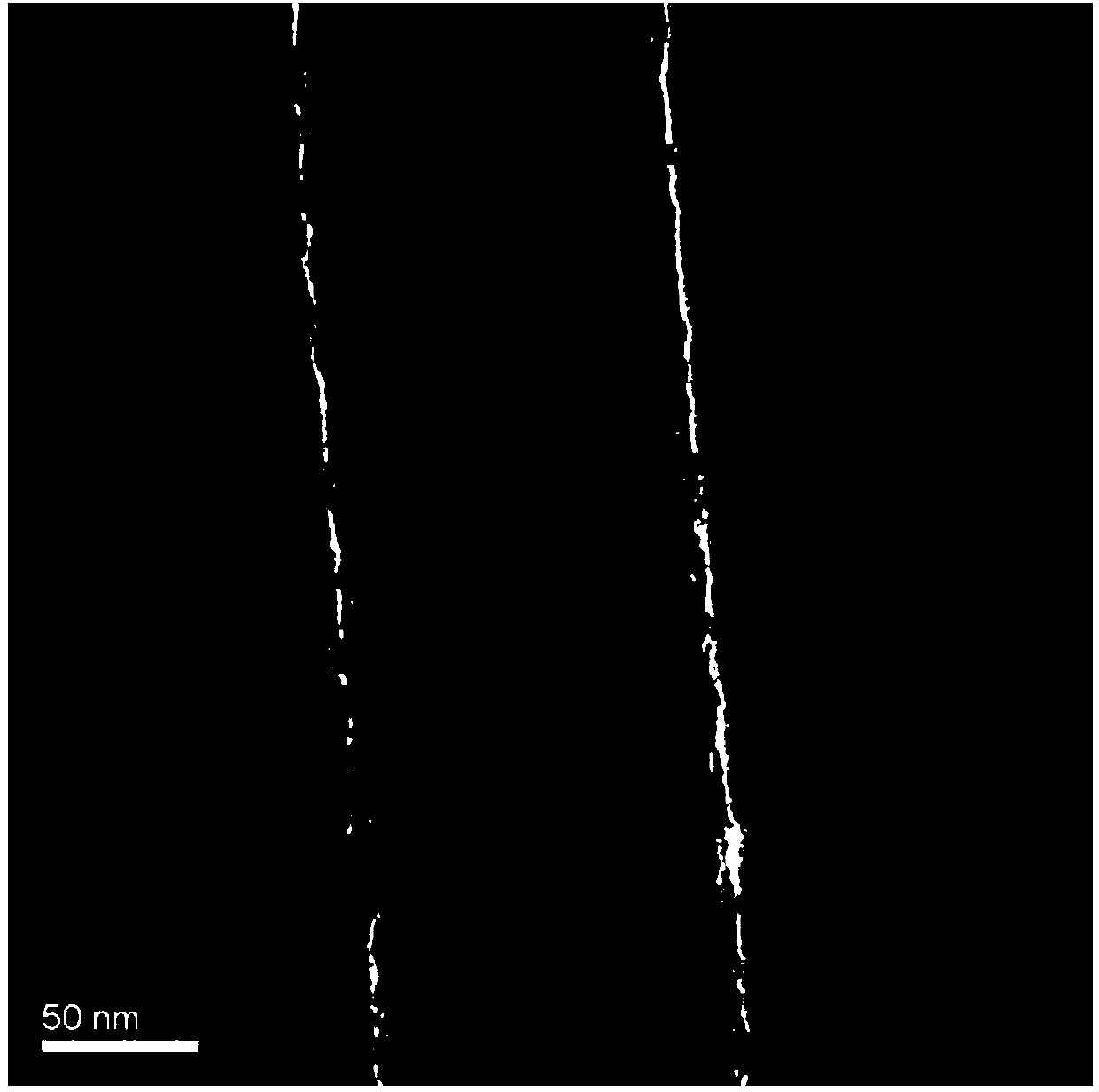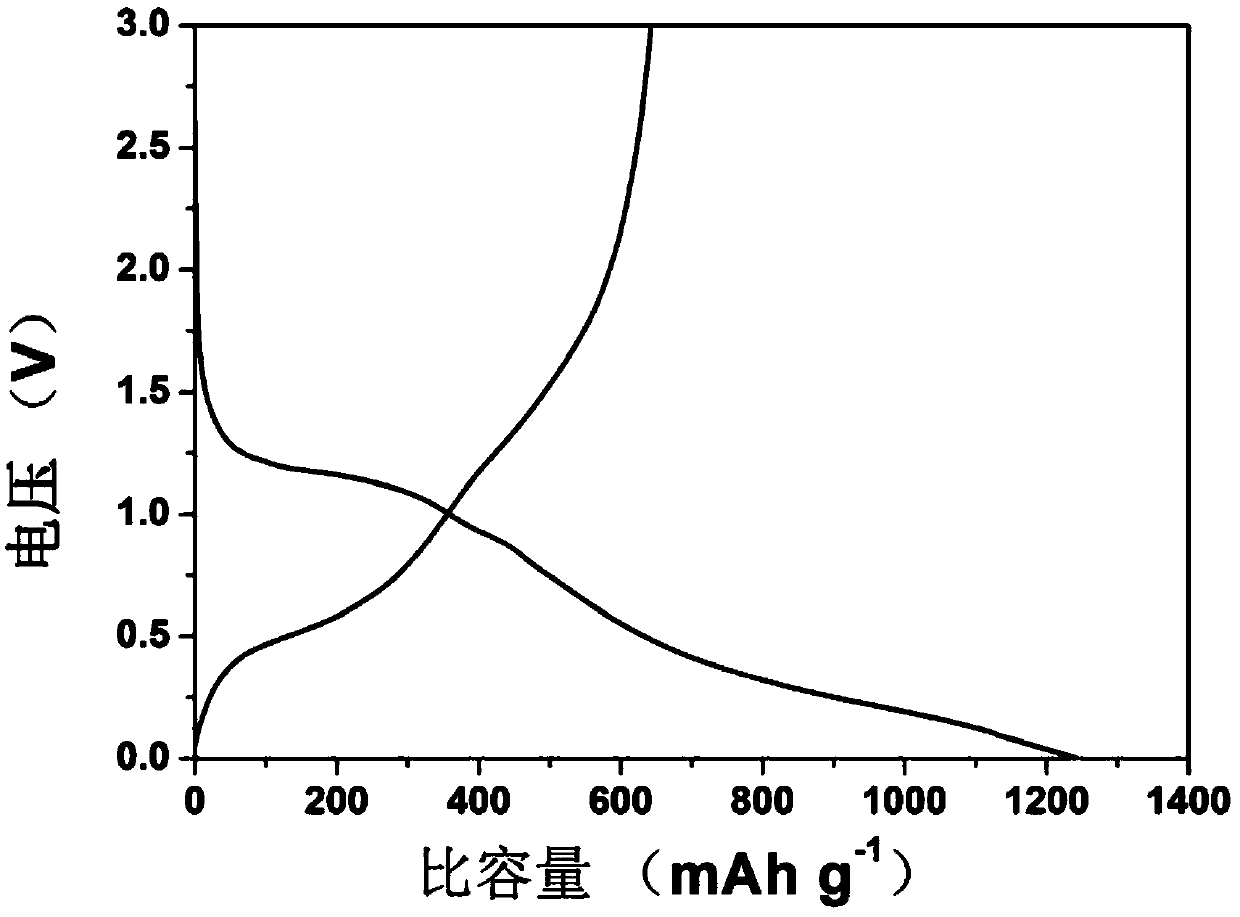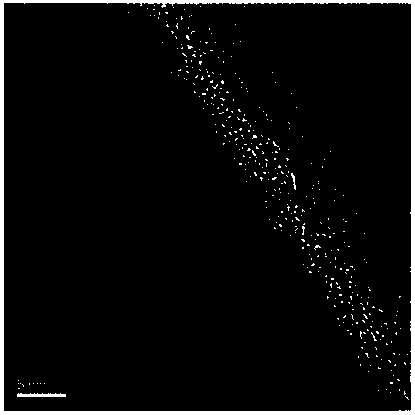Carbon nanofiber material and preparing method and application of carbon nanofiber material
A carbon nanofiber and nanofiber technology, applied in the field of carbon nanofiber materials and their preparation, can solve the problems of high cost and complex preparation method, and achieve the effects of preventing contact with electrolyte, shortening diffusion distance, and fast and continuous electron transmission
- Summary
- Abstract
- Description
- Claims
- Application Information
AI Technical Summary
Problems solved by technology
Method used
Image
Examples
Embodiment 1
[0024] Prepare electrospinning solution: add 0.5g of polyvinylpyrrolidone (PVP; Mw=1300000) to 10.5ml of absolute ethanol, then add 3.5ml of glacial acetic acid, stir for 3 to 5 hours, then add 1.0g of stannous octoate ( C 16 h 30 o 4 Sn) and 0.8g titanium isopropoxide (Ti(OiPr) 4 ), and stirred for 10 to 20 minutes to obtain an electrospinning solution. Wherein, the ratio of the amount of tin and titanium precursor substances is 1:1;
[0025]Preparation of polymer nanofiber membrane by electrospinning process: Pour the electrospinning solution into a syringe with a needle with an inner diameter of 1.2mm, in an environment with a temperature of 25-30°C and a relative humidity of 5-10%, with a voltage of 14kV Electrospinning at an injection speed of 0.5ml / h. Receive with the rotating drum that the rotating speed is 600rpm, and the receiving distance is controlled as 15cm. After the spinning time reaches 20h, the polymer nanofiber membrane is obtained;
[0026] The first ...
Embodiment 2
[0030] Configure the electrospinning solution: add 0.5g of polyvinylpyrrolidone (PVP; Mw=1300000) to 10.5ml of absolute ethanol, then add 3.5ml of glacial acetic acid, stir for 3 to 5 hours, then add 10.7g of stannous octoate ( C 16 h 30 o 4 Sn) and 0.8g titanium isopropoxide (Ti(OiPr) 4 ), and stirred for 10 to 20 minutes to obtain an electrospinning solution. Wherein, the ratio of the amount of substances of tin and titanium precursors is 10:1;
[0031] Preparation of polymer nanofiber membrane by electrospinning process: Pour the electrospinning solution into a syringe with a needle with an inner diameter of 0.9mm, in an environment with a temperature of 20-25°C and a relative humidity of 10-15%, with a voltage of 15kV Electrospinning at an injection speed of 0.6ml / h. Receive with the rotating drum that the rotating speed is 650rpm, and the receiving distance is controlled as 16cm. After the spinning time reaches 20h, the polymer nanofiber membrane is obtained;
[00...
Embodiment 3
[0036] Configure the electrospinning solution: add 0.5g of polyvinylpyrrolidone (PVP; Mw=1300000) to 10.5ml of absolute ethanol, then add 3.5ml of glacial acetic acid, stir for 3 to 5 hours, then add 0.5g of stannous octoate ( C 16 h 30 o 4 Sn) and 0.8g titanium isopropoxide (Ti(OiPr) 4 ), and stirred for 10 to 20 minutes to obtain an electrospinning solution. Wherein, the ratio of the amount of tin and titanium precursor substances is 1:2;
[0037] Preparation of polymer nanofiber membrane by electrospinning process: Pour the electrospinning solution into a syringe with a needle with an inner diameter of 1.0mm, in an environment with a temperature of 15-20°C and a relative humidity of 15-20%, with a voltage of 16kV Electrospinning at an injection speed of 0.7ml / h. Receive with the rotating drum that the rotating speed is 700rpm, and the receiving distance is controlled as 17cm. After the spinning time reaches 20h, the polymer nanofiber membrane is obtained;
[0038] Th...
PUM
| Property | Measurement | Unit |
|---|---|---|
| diameter | aaaaa | aaaaa |
| thickness | aaaaa | aaaaa |
Abstract
Description
Claims
Application Information
 Login to View More
Login to View More - R&D
- Intellectual Property
- Life Sciences
- Materials
- Tech Scout
- Unparalleled Data Quality
- Higher Quality Content
- 60% Fewer Hallucinations
Browse by: Latest US Patents, China's latest patents, Technical Efficacy Thesaurus, Application Domain, Technology Topic, Popular Technical Reports.
© 2025 PatSnap. All rights reserved.Legal|Privacy policy|Modern Slavery Act Transparency Statement|Sitemap|About US| Contact US: help@patsnap.com



